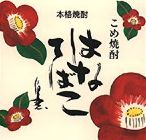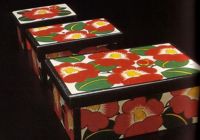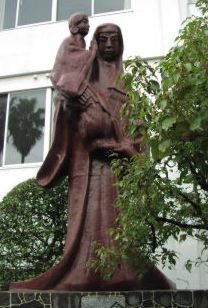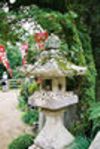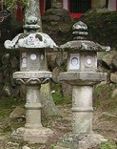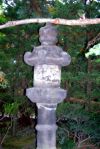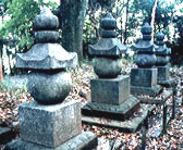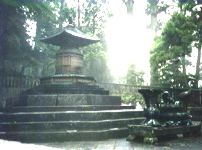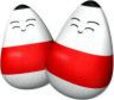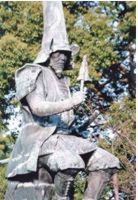|
CAMELLIA
BOXES
The Taira clan was virtually wiped away from this solar system by the Minamotos in 1185, at the battle of Dan no Ura. The Emperor, Antoku, 8 years old, died in the deep cold sea with the Taira matriarch who took him to drown herself with. Only a few survived. They scattered and had to start to make a living; something they never got accustomed to do. Some of these fugitives (the Minamotos still hunted them down) managed to conceal their identities and lived at a place called Hitoyoshi (that name means 'goodman') in today's Kumamoto Prefecture. They still had no idea of real life. One day soon they would get starved to death if such clumsy adaptation to rural lives never got improved. But one man among them found a craft accidentally just because his wife ached for the lacquerware left in Kyoto: this nagging wife made her husband to cut some pieces of cedar, constructed as boxes of jewelry (not that there was any to put into them), covered with handmade paper, and painted all over with camellias. Red camellia actually means 'in love' (see the meanings of Japanese flowers at another page), but the flower wasn't chosen for that meaning. They were painted on the simple and crude boxes for their color: deep red is the Taira's color (that's why it was also Oda Nobunaga's color). People around the area wanted the same boxes, so those were made for the market and preserved the few Tairas.
STONE
LANTERNS
Well, the Japanese imported stone lanterns from China, along with Zen Buddhism, in 574. Prince Regent Shotoku, who was some kind of a sinophile, took everything he could from the Chinese cargo. The first lanterns looked like the pic at the center. At first, because the Japanese had never even imagined such lanterns -- usually made of granite -- at all, they put the stuff only at temples and lit them only when there was a ceremony there. Fire is an offering, in Buddhism. Warlords since the Heian era (749) had a custom to give stone lanterns to temples as offerings. That's why Buddhist temples in Japan today are so crowded with them. Only a thousand years later (in 16th century) they started to apply the usual Japanese utilitarianism to the lanterns so that they functioned as lanterns -- to give artificial light at temples and paths. Lanterns look much like the traditional Japanese tombstones, which are called
KASATUBA
Why? Because both lanterns and tombstones or cenotaphs refer to the same guidebook of symbolicism: the Buddhist pagoda. The most common reference is the five-storeys pagoda or 'gorinto'. The top of which is to symbolize the ultimate bliss in Buddhism, which is 'nothingness' ('sunyatta'). Below it is the wind, then the fire, water, and finally earth. Those are the elements of the universe in Japanese and Chinese cosmologies. The first pic above shows the manifestation of the five 'spaces'; in this case cenotaphs of Oda Nobunaga's sons in Azuchi. Oda Nobunaga's cenotaph at the Kiyomizu temple of Kyoto (the second row of pix, at the left) is another example. Oda Nobunaga's cenotaph at Honno temple in Kyoto (see the second pic) is different. It is based on the thing called 'hokyointo', i.e. 'three-tiered stupa'. Only the elements of the earth, water, and fire are symbolized there. Tokugawa Ieyasu's extravagant tomb in Tokyo is the same old five-storey pagoda.
Click here for big pictures of the Tokugawa clan's mausoleum. |
O
K I A G A R I
This Shinto charm was originally male -- for the first maker of it was an overzealous Hachiman (God of War) believer. A major twist was made under the Tokugawa shogunate in 1800's of this charm. The Tokugawas imagined themselves as devout Buddhists, so okiagari was buddhified. It was supposed, from then on, to represent 'The Way' (what way? see the Zen page at this site). Shaped like daruma, okiagari always gets back to its upright position after getting swung backward or forward -- this, to the Buddhist thinking, is symbolical of a good believer. Made of wood first, then many other materials in 20th century, okiagari mutated into some feminine figure whose job is to give prosperity to its owner.
K
I N T A
To put it without any sugarcoating, the infantryman Kinta of the most famous Toyotomi General Kato Kiyomasa's Army was an imbecile. One of the Kato sergeants employed this man not for anything but to provide some free amusement when the clan was busy building Kumamoto castle -- a tedious and heavyweight job, so that anything was welcomed to light things up a bit. Since Kinta couldn't be in more than one place at a time, other Kato regiments stationed elsewhere -- all had heard of how funny Kinta was -- made some dolls -- usually painted all red, with movable tongue and eyes -- as substitutes. As time went by the paper dolls became popular handicraft items.
|
| Previous | Next |
PAGES OF LITTLE-KNOWN JAPANESE FACTS & LITTLE THINGS ABOUT JAPANESE SAMURAI
| 01 | 02 | 03 | 04 | 05 | 06 | 07 | 08 | 09 | 10 | 11 | 12 | 13 | 14 | 15 | 16 | 17 | 18 | 19 | 20 |
| 21 | 22 | 23 | 24 | 25 | 26 | 27 | 28 | 29 | 30 | 31 | 32 | 33 | 34 | 35 | 36 | 37 | 38 | 39 | 40 |
| 41 | 42 | 43 | 44 | 45 | 46 | 47 | 48 | 49 | 50 | 51 | 52 | 53 | 54 | 55 | 56 | 57 | 58 | 59 | 60 |
|
Site & Rap © 1996, 1997, 1998, 1999, 2000, 2001, 2002, 2003, 2004, 2005, 2006 Nina Wilhemina
Pictures for this section
are compiled by Obata Sugizo, Ryoku Nakane, Hasegawa Tomoko, Asada Kanae,
Matt Emery, Arisugawa Takashi, Sandy McClelland, James Kwan, Richard Rock,
Mary B. Morton, and Zui Rena
All rights reserved. Every borrowed image at this site is put for non-profit educational purposes only.
HOME
 LINKS
LINKS
 CONTACT
CONTACT
 CREDITS
CREDITS
 COMMENTS
COMMENTS
